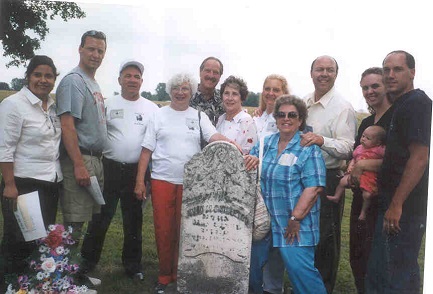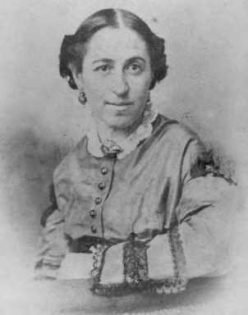
According to Emma Hale Smith’s handwritten account, in the Smith family Bible, her adopted daughter, Julia Murdock Smith was born May 1, 1831, in Warrensville, Ohio, to John and Julia Clapp Murdock. Her twin brother, Joseph, was also born the same day. The exact date of the birth comes into dispute but other contemporary information we have used the Smith family bible date in our data base, since that is the earliest recorded date.
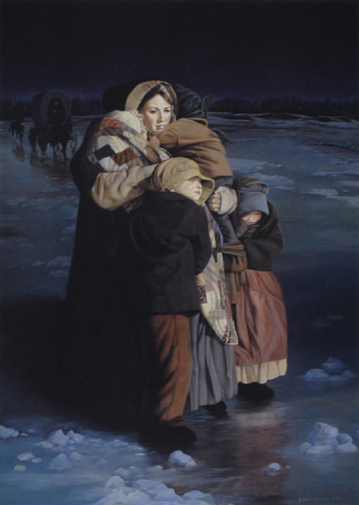 The Murdock twins were brought to Emma, who had lost her own twins, who were born and died on 30 April. At the age of seven, Julia shared young Joseph III’s trek with his parents out of Ohio, in 1838, and the hard winter trek out of Missouri, crossing the frozen Mississippi on foot holding onto Emma’s skirts as she fled to Quincy, Illinois in February 1839. All of her young life was filled with turmoil and when she was quite young she complicated her life by eloping with Elisha Dixon, at the age of seventeen, in 1848. For a time the couple attempted to run the Mansion House Hotel for Emma, but ill health prompted Elisha to move to a warmer climate. They moved to Galveston, Texas, where Elisha was employed on a River boat. His death in 1853, due to an explosion on the river boat, left Julia a widow with no children. She returned to Nauvoo and spent some time at the Mansion House with Emma before she remarried. On 19 November 1856, she was married to John Middleton who was a Catholic. They were married by the same Presbyterian minister who married Joseph Smith III and Emmeline Griswold that same year.
The Murdock twins were brought to Emma, who had lost her own twins, who were born and died on 30 April. At the age of seven, Julia shared young Joseph III’s trek with his parents out of Ohio, in 1838, and the hard winter trek out of Missouri, crossing the frozen Mississippi on foot holding onto Emma’s skirts as she fled to Quincy, Illinois in February 1839. All of her young life was filled with turmoil and when she was quite young she complicated her life by eloping with Elisha Dixon, at the age of seventeen, in 1848. For a time the couple attempted to run the Mansion House Hotel for Emma, but ill health prompted Elisha to move to a warmer climate. They moved to Galveston, Texas, where Elisha was employed on a River boat. His death in 1853, due to an explosion on the river boat, left Julia a widow with no children. She returned to Nauvoo and spent some time at the Mansion House with Emma before she remarried. On 19 November 1856, she was married to John Middleton who was a Catholic. They were married by the same Presbyterian minister who married Joseph Smith III and Emmeline Griswold that same year.
One year after their marriage, 9 November 1857, Julia was baptized at the Church of St. Francis Xavior, in St. Louis, and on November 11, she was confirmed in the Church of the Immaculate Conception.
It was not until late in 1858 that correspondence occurred between Julia and her brother, John Murdock, and later from her father. Julia did not choose to continue contact her father, though she saved his letter, and later had ongoing correspondence with her brother. Julia explained in her letter to her brother than she had lived a bitter life, feeling confused and abandoned by her ‘real’ family, but fearful too that they would take her away from those who raised her and whom she loved.
Julia’s letters to Emma clearly reveal that she devotedly loved her adopted mother and brothers, and held in reverent memory her father, Joseph Smith Jr. When Joseph Smith III took leadership of the Reorganization in 1860, Julia was not motivated to join in his cause, for she was already settled into her life as a devout Catholic.
John Middleton became an alcoholic and was abusive to Julia both physically and emotionally; the marriage ended in divorce, and she returned to Nauvoo, in 1876. There were no children in this marriage as well. She was with Emma at the difficult time when David Hyrum was placed in the mental hospital at Elgin, Illinois. And she was there to tend to Emma during her last illness and present at her death, 30 April 1879. After Emma’s death, Alexander and Elizabeth invited Julia to come to them at their farm near Andover, Missouri. Julia herself was unwell, suffering from breast cancer. While with Alexander’s family, niece, Vida Elizabeth Smith wrote of her:
“She was a source of great delight to the older children of our home, for she as a delightful talker and had led a most romantic and unusual life that she picked stories from here and there and told to us in the shut-in weeks (winter) on the farm. Stories form a life as brilliant and wonderful and proud as the glowing pages of a fairy tale, and at last as sad and unlovely and poor as the most prosaic of life stories. It was indeed a strange story that began in that little Ohio town among a hunted and persecuted people.” (Vida E. Smith, “Biography of Patriarch Alexander Hale Smith,” Journal of History, Vol. 6 (Lamoni, Iowa: Board of Education of the Reorganized Church of Jesus Christ of Latter Day Saints, 1911).
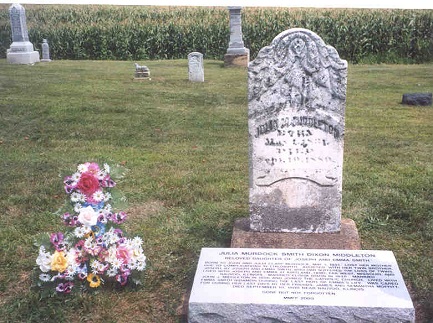
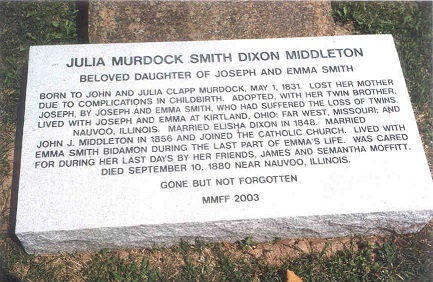
In the spring of 1880, Julia decided to visit her friends, Samantha and James Moffitt, in Nauvoo; while there she became too ill to return to Missouri, and she died in the Moffitt’s home, 10 Sept, 1880. Her burial took place in the St. Peter and Paul Cemetery in Nauvoo. Julia left no posterity.
In 2003, her grave was marked by a memorial placed by the Missouri Mormon Frontier Foundation in a ceremony attended by many Murdocks, Moffitts, and Smiths descendants. The words engraved on her first grave marker were repeated on the new one: “Gone but Not Forgotten”
